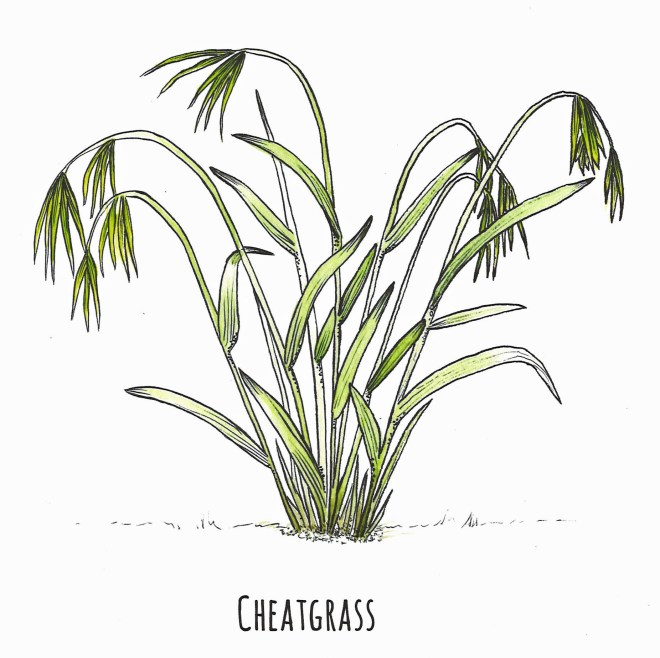Plant intelligence is a burgeoning field of research. Despite being predominantly sessile organisms, plants are able to sense their surroundings and make decisions based on environmental cues. In a certain sense, they can see, hear, smell, and remember even though they don’t have eyes, ears, noses, or brains. Not surprisingly, these fascinating findings have spawned books, podcasts, documentaries, articles, etc. The idea that plants could be intelligent beings like us is something that captures our attention and imagination.
For example, if plants are so smart, does this mean that they actually have thoughts? And if they have thoughts, what could they possibly be thinking? In her new book, What Weeds Are Thinking, Erica Crockett takes a stab at what a particularly despised group of plants might think if, indeed, they could have thoughts. Weeds are, in Crockett’s words, “the deviants of the plant world.” This book was her chance to imagine what might be going on inside the minds of these deviants, despite the fact that they don’t have minds. Crockett conjures up the thoughts of 21 different weeds. Each thought is accompanied by an illustration by Sarah Ragan Olson. The drawings are charming, but the thoughts that juxtapose them aren’t always so sweet. Perhaps you imagine weeds to be potty mouthed? Well, so does Crockett. That being said, this book is not for kids, nor is it for anyone sensitive to adult words and themes. Each of the weeds in this book varies in its degree of irreverence – not all of them are so crass and some of them are actually pretty mild-mannered – but that’s just what you’d expect from such a diverse group of plants.
Crockett conjures up the thoughts of 21 different weeds. Each thought is accompanied by an illustration by Sarah Ragan Olson. The drawings are charming, but the thoughts that juxtapose them aren’t always so sweet. Perhaps you imagine weeds to be potty mouthed? Well, so does Crockett. That being said, this book is not for kids, nor is it for anyone sensitive to adult words and themes. Each of the weeds in this book varies in its degree of irreverence – not all of them are so crass and some of them are actually pretty mild-mannered – but that’s just what you’d expect from such a diverse group of plants.
Comfrey is offended by cow manure being used as fertilizer and would rather be fertilized by “the decaying corpses of [its] relations.” Ground ivy is embarrassed and offended by inadvertently seeing the ankles of human passersby. Plantain is apparently into being stepped on, and prostrate spurge is trying to “rebrand” to make itself more appealing and set itself apart from purslane. Cheatgrass, no surprise here, comes across as a big jerk. Originally from Eurasia, it is now a freedom-loving American, “choking out the rights of the natives.”
Most in line with what I would expect a weed to be thinking – especially one found growing in an urban area – is prickly lettuce. Upset after watching a fellow member of its species ruthlessly dug up, it laments: “Neither of us decided to seed down in the deep crack of this suburban driveway. We were blown here…It’s our home…Yet we are hunted.”
Milkweed is quite aware of its role as the sole food source of the monarch caterpillar. It sees how much humans appreciate monarchs, and admonishes us for killing off its kind: “Keep it up, and I’ll take every last one of those delicate darlings down with me.”
Botanical inaccuracies aside – and there are several – this was a fun book. The main appeal for me is that it is plant-themed and, more specifically, weeds-themed. If you follow this blog, you’ll know that pretty much anything involving weeds is going to get my attention. Beyond that, any project that puts plants in the spotlight and gives them a voice (even in a fictitious sense) is worth checking out. This book is no exception.
As a bonus, I asked Erica Crockett what other plants (apart from weeds) are thinking. This was her response: “Probably really precious or intellectual things. I imagine tomato plants are fairly self-important and zonal geraniums are divas. Bougainvilleas are likely social climbers and oak trees are dull, but honest.”




Pingback: 2018: Year in Review – awkward botany
Pingback: Book Review: The Gyroscope of Life – awkward botany
Pingback: Book Review: In Defense of Plants – awkward botany
Pingback: In Praise of Vagabond Plants – A Book Review – awkward botany